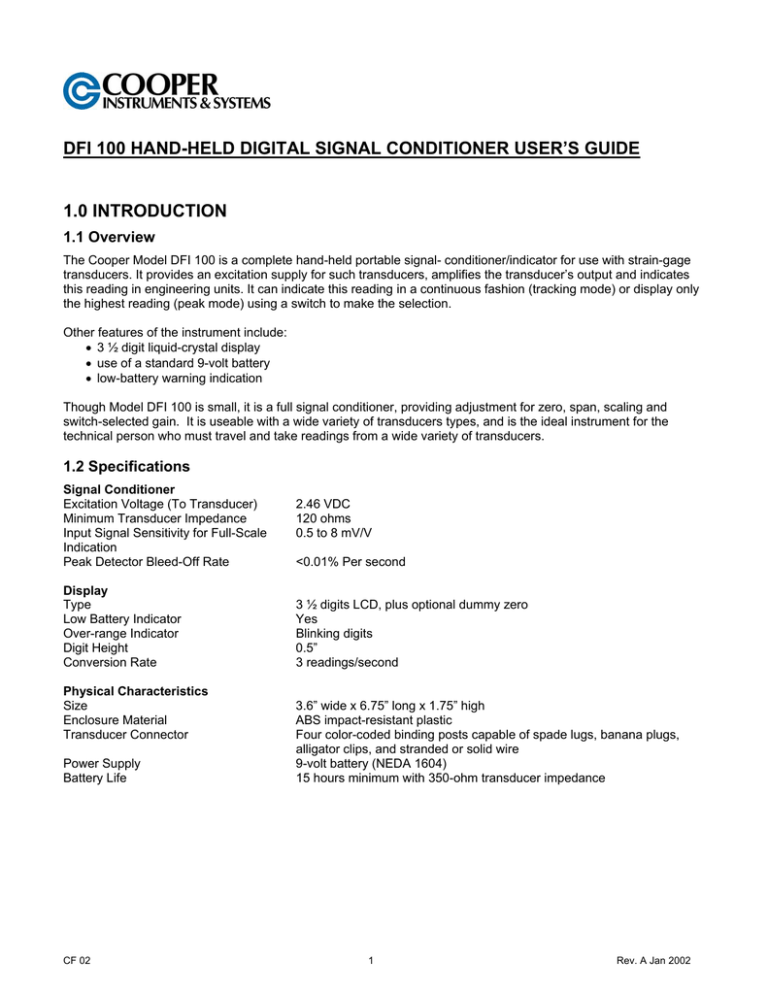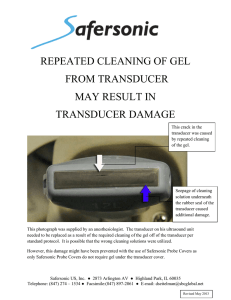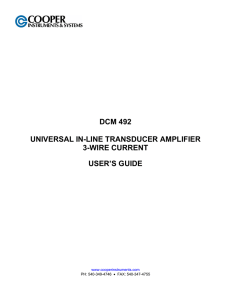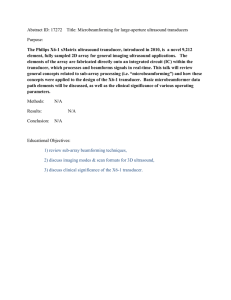dfi 100 hand-held digital signal conditioner
advertisement

DFI 100 HAND-HELD DIGITAL SIGNAL CONDITIONER USER’S GUIDE 1.0 INTRODUCTION 1.1 Overview The Cooper Model DFI 100 is a complete hand-held portable signal- conditioner/indicator for use with strain-gage transducers. It provides an excitation supply for such transducers, amplifies the transducer’s output and indicates this reading in engineering units. It can indicate this reading in a continuous fashion (tracking mode) or display only the highest reading (peak mode) using a switch to make the selection. Other features of the instrument include: • 3 ½ digit liquid-crystal display • use of a standard 9-volt battery • low-battery warning indication Though Model DFI 100 is small, it is a full signal conditioner, providing adjustment for zero, span, scaling and switch-selected gain. It is useable with a wide variety of transducers types, and is the ideal instrument for the technical person who must travel and take readings from a wide variety of transducers. 1.2 Specifications Signal Conditioner Excitation Voltage (To Transducer) Minimum Transducer Impedance Input Signal Sensitivity for Full-Scale Indication Peak Detector Bleed-Off Rate Display Type Low Battery Indicator Over-range Indicator Digit Height Conversion Rate Physical Characteristics Size Enclosure Material Transducer Connector Power Supply Battery Life CF 02 2.46 VDC 120 ohms 0.5 to 8 mV/V <0.01% Per second 3 ½ digits LCD, plus optional dummy zero Yes Blinking digits 0.5” 3 readings/second 3.6” wide x 6.75” long x 1.75” high ABS impact-resistant plastic Four color-coded binding posts capable of spade lugs, banana plugs, alligator clips, and stranded or solid wire 9-volt battery (NEDA 1604) 15 hours minimum with 350-ohm transducer impedance 1 Rev. A Jan 2002 1.3 Layout 1.3.1 Front Panel Controls/Indicators ON/OFF Switch [SHUNT CAL] Switch [PEAK/TRACK] Switch [ZERO] POTENTIOMETER [SPAN] POTENTIOMETER “LO BAT” Indicator The ON/OFF switch controls power to the instrument from the battery. This switch connects the instrument’s shunt calibration resistor to the transducer and is used during setup. See “SETUP” for more information. The PEAK/TRACK switch selects the mode of operation of the instrument. In the TRACK mode, the instrument’s display will continuously follow the transducer reading. In the PEAK position, the instrument will retain and display the value of the most positive value detected during operation. To reset the peak, switch the PEAK/TRACK switch to the TRACK position. (A slight decay of peak value displayed over an extended period of time is normal). The ZERO potentiometer is used to obtain a zero indication, thus canceling drifts or offsets that could exist in the instrument or transducer. The SPAN potentiometer adjusts the fine gain or the amplifier. It is used to make certain that the reading obtained from any transducer can be scaled to the proper level on the display. This indication appears in the upper-left of the display and indicates when the battery voltage is getting low. + Excitation -IN -EX +IN - Excitation +EX + Signal -Signal PIN OUT AS SEEN LOOKING INTO THE CONNECTOR ON THE METER FROM THE OUTSIDE REAR OF CASE Wiring For Mating Connector 4 Pin Mini Din Connector SPAN ZERO ON SHUNT PEAK OFF CAL TRACK + Excitation - Excitation - Signal +Signal Rectangle Tab LOOKING INTO THE MATING CONNECTOR FROM THE FRONT OF THE CASE WITH THE BOTTOM PLASTIC RECTANGLE TAB Figure 1-Layout 1.3.2 Connection Terminals On the top of the instrument are four binding-post connectors for the transducer connections. Labels describe the function of each of the terminals. Instrument +EX -EX +IN -IN Transducer (+) Excitation (-) Excitation (+) Output (-) Output Table 1: Transducer Hookup CF 02 2 Rev. A Jan 2002 1.3.3 Battery Replacement The access door for the battery is located on the rear of the instrument. To replace the battery, slide the door in the direction indicated by the arrow. When changing batteries, remove the clip from the battery carefully, in order to protect the wiring. 2.0 SETUP 2.1 Initial Setup If your DFI 100 was purchased with a Cooper transducer and Assembly & Calibration, the system is calibrated. You may skip this section. 1. Remove the rear panel from the DFI 100 by removing the four corner screws and carefully lifting the rear off. Use caution not to strain the wires running to the battery compartment. 2. Decimal Point Setting – Determine the desired location for the decimal point on the digital display. See Figure 2. Connect the proper decimal point jumper, as shown. CAUTION! Use only one jumper! 3. Extra (Dummy) Zero – It is possible to have an extra zero digit at the end of the displayed value, if desired. Decide if the extra zero is required on the display. Place a jumper so that this digit is on or off, as shown in Figure 2. 4. Coarse Gain – Determine the transducer’s full-scale output. The DFI 100 will give a full-scale indication for transducers with outputs from 0.5 to 8.0 millivolts per volt. Figure 2 indicates the switch selections for eight selector switches, which set the coarse gain of the DFI 100. Table 1 indicates the switch positions needed to accommodate the various millivolt-per-volt inputs. This completes the initial setup of the instrument for any transducer. Do not replace the rear panel, yet. mV/V Values 0.5 .75 1 1.5 2 2.5 3 3.5 4 5 6 7 8 Switches On 1,2,3,7 1,3,7 1 3,5,7 2 4,7 3 6,8 4 5 6 7 8 Table 2 Coarse Gain Switch Settings 2.2 Transducer Hookup Connect the transducer to the DFI 100 using the binding post connectors shown in Figure 1. Observe the proper color-coding as shown on the Transducer Information Sheet provided with your transducer. Energize the DFI 100, and allow the transducer a few seconds to warm up, thus stabilizing any zero shift. 2.3 Transducer Setup 1. Locate the internal SCALING potentiometer (see “Printed Circuit Board” on page 5). Turn it fully clockwise (about 25 turns). 2. With no load applied to the transducer, adjust the front-panel ZERO control to give a zero indication on the display. 3. Known Load Method: With a known load close to full-scale to the transducer, adjust the SPAN potentiometer so that the display reads 1999 (or 19990 if the extra digit is turned on.) CF 02 3 Rev. A Jan 2002 Shunt Calibration Method: An alternative to this step is to use the SHUNT CAL switch to simulate a load, adjusting the SPAN control so that the display reads value calculated by the following: If an extra zero digit is selected, the display should read: Shunt Cal Output (mV/V) x 19990 Full-Scale Output mV/V If the extra zero digit is NOT selected, the display should read: Shunt Cal Output (mV/V) x 1999 Full-Scale Output mV/V These values are normally found on the calibration sheets that are included with the transducer by most manufacturers. The value of the SHUNT CAL resistor that the manufacturer recommends is also on this sheet. It is important that the same value resistor be used when using the SHUNT CAL method. 4. Recheck the ZERO and again apply the known load or SHUNT CAL. 5. With the full-load applied; adjust the internal SCALING potentiometer to the desired full-scale engineering unit value. If the SHUNT CAL technique is being used, adjust for the value calculated by: Shunt Cal Output mV/V x Full-Scale Engineering Units Full-Scale Output mV/V 6. Replace the rear panel. Calibration and setup are now complete. Figure 2-Printed Circuit Board CF 02 4 Rev. A Jan 2002 3.0 WARRANTY REPAIR POLICY Limited Warranty on Products Any Cooper Instruments product which, under normal operating conditions, proves defective in material or in workmanship within one year of the date of shipment by Cooper will be repaired or replaced free of charge provided that a return material authorization is obtained from Cooper and the defective product is sent, transportation charges prepaid, with notice of the defect, and it is established that the product has been properly installed, maintained, and operated within the limits of rated and normal usage. Replacement or repaired product will be shipped F.O.B. from our plant. The terms of this warranty do not extend to any product or part thereof which, under normal usage, has an inherently shorter useful life than one year. The replacement warranty detailed here is the buyer’s exclusive remedy, and will satisfy all obligations of Cooper whether based on contract, negligence, or otherwise. Cooper is not responsible for any incidental or consequential loss or damage which might result from a failure of any and all other warranties, express or implied, including implied warranty of merchantability or fitness for particular purpose. Any unauthorized disassembly or attempt to repair voids this warranty. Obtaining Service under Warranty Advance authorization is required prior to the return to Cooper Instruments. Before returning the item, contact the Repair Department c/o Cooper Instruments at (540) 349-4746 for a Return Material Authorization number. Shipment to Cooper shall be at buyer’s expense and repaired or replacement items will be shipped F.O.B. from our plant in Warrenton, Virginia. Non-verified problems or defects may be subject to a $100 evaluation charge. Please return the original calibration data with the unit. Repair Warranty All repairs of Cooper products are warranted for a period of 90 days from date of shipment. This warranty applies only to those items that were found defective and repaired; it does not apply to products in which no defect was found and returned as is or merely recalibrated. It may be possible for out-of-warranty products to be returned to the exact original specifications or dimensions. * Technical description of the defect: In order to properly repair a product, it is absolutely necessary for Cooper to receive information specifying the reason the product is being returned. Specific test data, written observations on the failure and the specific corrective action you require are needed. CF 02 5 Rev. A Jan 2002




